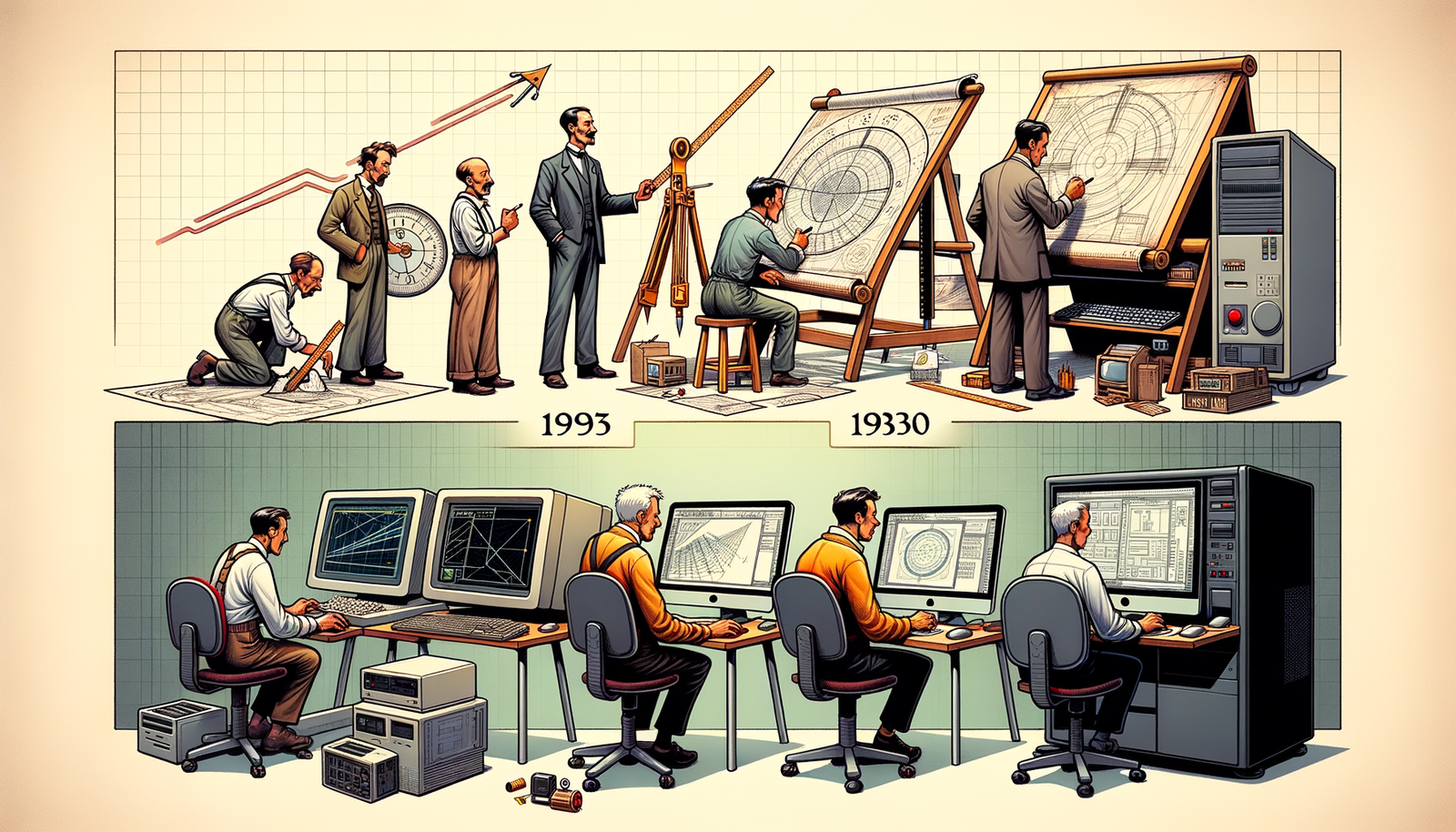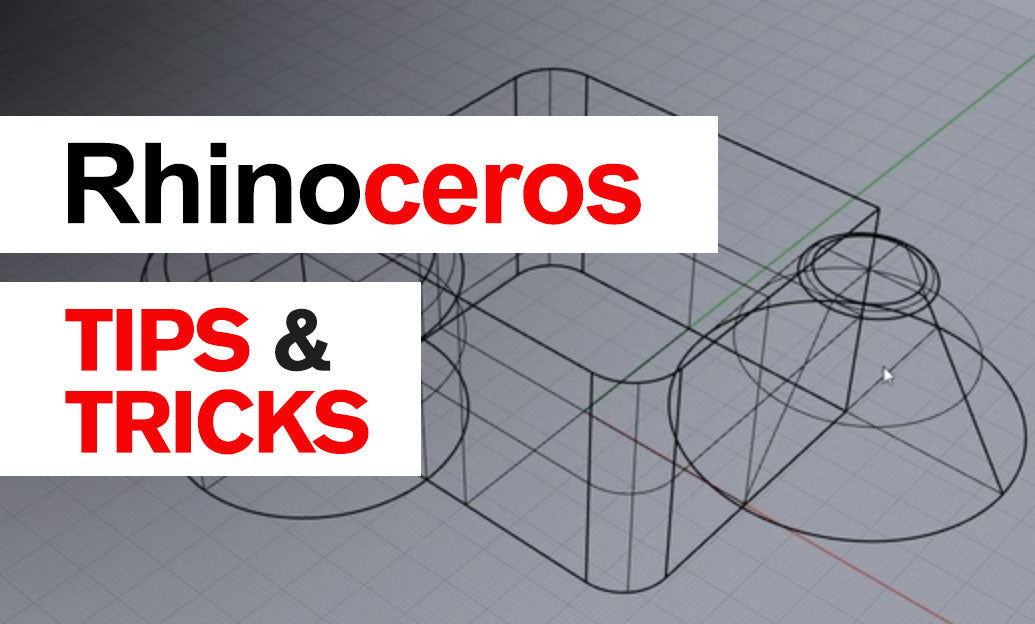Your Cart is Empty
Customer Testimonials
-
"Great customer service. The folks at Novedge were super helpful in navigating a somewhat complicated order including software upgrades and serial numbers in various stages of inactivity. They were friendly and helpful throughout the process.."
Ruben Ruckmark
"Quick & very helpful. We have been using Novedge for years and are very happy with their quick service when we need to make a purchase and excellent support resolving any issues."
Will Woodson
"Scott is the best. He reminds me about subscriptions dates, guides me in the correct direction for updates. He always responds promptly to me. He is literally the reason I continue to work with Novedge and will do so in the future."
Edward Mchugh
"Calvin Lok is “the man”. After my purchase of Sketchup 2021, he called me and provided step-by-step instructions to ease me through difficulties I was having with the setup of my new software."
Mike Borzage
Design Software History: The Evolution of Design Software: From Manual Drafting to Ivan Sutherland's Sketchpad and Its Lasting Impact on CAD Technologies
January 05, 2025 12 min read


Overview of Design Practices in the Pre-Sketchpad Era
In the era preceding Ivan Sutherland's revolutionary Sketchpad system, design practices were predominantly manual, relying heavily on traditional drafting techniques. Engineers, architects, and designers utilized tools such as pencils, compasses, protractors, and T-squares to create technical drawings on paper or vellum. This method was not only time-consuming but also prone to errors and inconsistencies. Redrawing or modifying designs required significant effort, often necessitating the recreation of entire drawings to incorporate changes. The limitations of manual drafting hindered the efficiency of the design process, making it difficult to explore multiple design variants or to rapidly iterate on concepts. Furthermore, the lack of digital tools meant that collaboration between teams was challenging. Sharing and duplicating drawings involved physical copying, which increased the risk of miscommunication and data loss. The storage and maintenance of large volumes of physical drawings also posed logistical difficulties. As industries grew more complex and the demand for intricate designs increased, the need for more efficient and accurate design processes became apparent. Prior to Sketchpad, early attempts at computer-aided design were rudimentary and lacked interactive capabilities. Computers were primarily used for numerical computations with limited graphical interfaces. Some research explored the potential of using computers for drafting, but these systems were generally non-interactive, relying on batch processing and punched cards. The output was typically printed on line printers or plotted using primitive devices, offering little in terms of real-time visualization or manipulation. The convergence of growing computational power and the recognition of these limitations set the stage for innovation in computer-aided design.Importance of the Sketchpad Innovation
Ivan Sutherland's Sketchpad emerged as a pivotal innovation that fundamentally altered the trajectory of computer-aided design (CAD). By introducing the concept of an interactive graphical interface, Sketchpad set the stage for all subsequent CAD systems. It enabled designers to communicate directly with a computer through graphical means, revolutionizing the way humans interacted with machines. This shift allowed for real-time creation, manipulation, and modification of graphical objects, which was unprecedented at the time. Sketchpad's impact extended beyond mere technological advancement; it represented a new paradigm in design thinking. By facilitating rapid prototyping and visualization, it empowered designers to explore more creative solutions and to iterate quickly on their ideas. This capability was especially significant in fields like engineering and architecture, where visual representation and precision are paramount. Ivan Sutherland, a visionary computer scientist and electrical engineer, played a crucial role in bringing this innovation to life. With a background that included studies at Carnegie Mellon University, the California Institute of Technology, and the Massachusetts Institute of Technology (MIT), Sutherland was well-positioned to push the boundaries of computer graphics. His vision for computer-aided design was rooted in the belief that computers could be more than computational devices—they could be tools for creativity and expression. Sketchpad not only transformed design methodologies but also laid the groundwork for future developments in human-computer interaction. Its influence can be seen in modern graphical user interfaces, object-oriented programming, and interactive computing. The system demonstrated that complex computations and graphical manipulations could be made accessible and intuitive, a concept that continues to underpin software development today.Background and Development of Sketchpad
Ivan Sutherland's journey toward the creation of Sketchpad was shaped by his extensive academic and professional experiences. Born in 1938, Sutherland showed early aptitude in mathematics and engineering, leading him to pursue a bachelor's degree in electrical engineering at Carnegie Mellon University. He then obtained a master's degree from the California Institute of Technology, where he delved deeper into the realms of electronics and computation. However, it was during his doctoral studies at MIT that Sutherland made his most significant contributions. At MIT, under the mentorship of Claude Shannon and Marvin Minsky, Sutherland immersed himself in cutting-edge research at the Lincoln Laboratory and the MIT Computation Center. The environment was ripe with innovation, focusing on extending the capabilities of computers beyond traditional numerical calculations. Sutherland's doctoral thesis, titled "Sketchpad: A Man-Machine Graphical Communication System," became the cornerstone of his legacy. The development of Sketchpad involved several key technical innovations that were groundbreaking for the time. One of the most significant was the implementation of the graphical user interface (GUI), which allowed users to interact with the computer through visual and graphical elements rather than solely through text-based commands. This was facilitated by the use of the TX-2 computer, which was among the first machines capable of handling graphical outputs. Sketchpad introduced the concept of hierarchical modeling, where complex drawings could be built from simpler components or "sub-pictures." This allowed for more efficient memory usage and organizational structure within designs. Additionally, Sutherland implemented constraints and relationships between graphical objects, enabling the system to maintain geometric relationships automatically when modifications were made. This feature was a precursor to modern parametric and constraint-based modeling found in today's CAD software. Another technical innovation was the real-time interaction between the user and the system, a departure from the batch processing typical of computers at the time. Sutherland's work demonstrated that computers could provide immediate feedback, which was essential for practical design applications. The combination of these innovations made Sketchpad a revolutionary tool that not only advanced computer graphics but also influenced the development of interactive computing as a whole.Core Features of Sketchpad
Sketchpad's core features were a synthesis of innovative concepts that together forged a new path for computer interaction and graphical design. Central to Sketchpad was the concept of an interactive graphical interface, which allowed users to draw directly on the computer display and manipulate graphical objects in real time. This marked a significant departure from previous computational interfaces that relied solely on text-based input and output. One of the most notable features of Sketchpad was its utilization of a light pen as a user input device. The light pen, a precursor to modern pointing devices, enabled users to interact directly with the display screen. By pointing the light pen at the cathode-ray tube (CRT) monitor, users could draw lines, create shapes, and select or modify existing objects. This direct manipulation interface provided an intuitive and natural way for users to engage with the computer, mirroring the experience of drawing on paper. Sketchpad was capable of real-time visualization and manipulation of geometric shapes, a groundbreaking achievement for the era. Users could create and modify lines, circles, and complex geometric figures with immediate visual feedback. The system supported features such as copying, scaling, and rotating objects, as well as defining constraints between them. For example, a user could specify that two lines must remain parallel or that a point must always lie on a particular line. When one object was adjusted, Sketchpad would automatically adjust related objects to maintain these constraints. Some of the core features of Sketchpad included:- Interactive Graphical Interface: Allowed direct drawing and manipulation on the display.
- Utilization of a Light Pen: Provided intuitive, direct input and control over graphical elements.
- Real-time Visualization: Enabled immediate feedback and adjustments to designs.
- Hierarchical Modeling: Supported building complex drawings from simpler subcomponents.
- Constraint Satisfaction: Maintained geometric relationships automatically during modifications.
Immediate Influence on Subsequent Technologies
The immediate influence of Sketchpad on subsequent technologies was profound, as it directly inspired a new wave of research and development in computer graphics and design software. Sketchpad's demonstration of interactive computer graphics spurred interest among researchers and practitioners who recognized the potential applications across various fields. One of the direct descendants of Sketchpad was the development of the Graphics Design Language (GDL) by Timothy Johnson and others, which expanded on Sketchpad's capabilities by introducing more sophisticated graphical functions. Contemporary systems influenced by Sketchpad began emerging in the years following its introduction. Research institutions like Stanford University and the University of Utah became hubs for computer graphics innovation, building upon the concepts introduced by Sutherland. For instance, the work on the Aspen Movie Map at MIT and developments in three-dimensional object representation were rooted in the principles established by Sketchpad. In industry, companies such as IBM and General Motors started exploring computer-aided design for practical applications. They saw the potential for improving product development cycles, enhancing precision, and reducing costs. The automotive and aerospace industries were among the first to adopt CAD technologies, driven by the need for complex designs and stringent accuracy requirements. The influence of Sketchpad was evident in these early CAD systems, which incorporated interactive graphics, real-time manipulation, and the use of constraints. The adaptation of Sketchpad's concepts was not limited to design software. The field of human-computer interaction (HCI) as a whole was transformed, with researchers investigating new ways for users to interact with computers. The idea of a graphical user interface, which would later become ubiquitous with the introduction of personal computers, can trace its origins back to the interactive principles demonstrated by Sketchpad. The immediate impact of Sketchpad was a catalyst for a technological revolution, setting in motion advancements that would shape the future of computing. Its influence extended beyond academia into industry, prompting a reimagining of how computers could be used in design, engineering, and beyond.Long-term Effects on CAD/CAM Systems
The long-term effects of Sketchpad on computer-aided design (CAD) and computer-aided manufacturing (CAM) systems are profound and enduring. Sketchpad laid the foundational architecture upon which modern CAD platforms are built. The evolution from Sketchpad to contemporary CAD systems involved the integration of more advanced features, increased computational power, and the expansion into three-dimensional modeling. Companies like Dassault Systèmes with CATIA, Autodesk with AutoCAD, and PTC with Creo developed sophisticated software that allowed for complex design and engineering tasks, all tracing back to the principles established by Sutherland's work. One of the significant contributions of Sketchpad to modern CAD systems is the introduction of object-oriented programming (OOP) concepts. Sketchpad's use of "master drawings" and "instances" is akin to the OOP concept of classes and objects. This approach allowed for reusability and hierarchical structuring of design elements, making it easier to manage complex projects. The encapsulation of data and functions within objects in CAD software enhances modularity and scalability, critical for large-scale engineering projects. Other key long-term effects include:- Constraint-Based Modeling: Introduced automated maintenance of design relationships.
- Interactive Graphics: Set the standard for real-time design manipulation.
- Integration with CAM: Facilitated the direct translation of designs into manufacturing processes.
- Parametric Design: Enabled design parameters to drive geometry adjustments.
Prominent Figures and Collaborations Inspired by Sketchpad
Sketchpad not only influenced technology but also inspired a generation of pioneers in computer graphics and design software. Ivan Sutherland's work became a cornerstone that attracted brilliant minds to the field. Notably, figures such as Alan Kay, who developed the concept of the Dynabook and contributed significantly to object-oriented programming, were inspired by the interactive and graphical capabilities demonstrated by Sketchpad. Another prominent figure is Edwin Catmull, co-founder of Pixar Animation Studios, who was influenced by the advancements in computer graphics initiated by Sutherland. Catmull's work in rendering and animation techniques built upon the graphical foundations laid by Sketchpad. His contributions have been instrumental in the evolution of computer-generated imagery (CGI) in film and animation. Sutherland's influence extended through his teaching and collaborations. As a professor at the University of Utah, he mentored students who would become leaders in the field, such as Jim Clark, founder of Silicon Graphics Inc. (SGI), and John Warnock, co-founder of Adobe Systems. The University of Utah became a powerhouse in computer graphics research, largely due to the environment fostered by Sutherland. Collaborations resulting from Sutherland's work also played a significant role in advancing technology. For example, his partnership with David Evans led to the founding of Evans & Sutherland, a company specializing in computer graphics hardware and software. Their work on flight simulators and graphic systems pushed the boundaries of what was technologically possible, influencing both military and commercial sectors. These collaborations and the network of innovators who were inspired by Sketchpad catalyzed progress in numerous areas, including virtual reality, animation, and user interface design. The ripple effect of Sutherland's pioneering efforts demonstrates the profound impact that groundbreaking research can have, not only on technology but also on the people who drive innovation forward.Sketchpad as a Paradigm Shift in Design Methodologies
Sketchpad represents a paradigm shift in design methodologies, marking the transition from manual drafting to digital design processes. By integrating computation with graphical interaction, Sketchpad transformed the way designers conceptualize and execute their ideas. This digital approach introduced efficiencies and capabilities that were unattainable with traditional methods, such as rapid prototyping, easy modification of designs, and the ability to handle complex geometries. The transformation of design processes through digital means has had far-reaching implications. In architecture, professionals can now create intricate models, perform structural analyses, and visualize their designs in three dimensions before construction begins. In engineering, digital design tools have enabled the simulation of systems, stress testing, and optimization of components, leading to higher-quality and more reliable products. Sketchpad's enduring legacy in current design and engineering software is evident in the features and functions that are now standard. The use of layers, grouping, and hierarchical organization of design elements can be traced back to Sketchpad's concept of sub-pictures. The integration of constraints and parametric modeling allows for intelligent design adjustments, maintaining relationships and proportions automatically. Moreover, Sketchpad has influenced the user experience of software across various industries. The intuitive, interactive interfaces that users now expect are rooted in the principles of direct manipulation and immediate feedback introduced by Sketchpad. This influence has extended beyond design software into general computing, affecting operating systems, mobile applications, and web design. The paradigm shift initiated by Sketchpad has led to the democratization of design tools. With the advent of accessible software, individuals and small businesses can engage in design activities that were once the domain of large corporations with substantial resources. This democratization has spurred innovation and creativity, contributing to advancements in technology, art, and culture.Recognition and Awards
Ivan Sutherland's contributions through Sketchpad have been widely recognized and honored within the scientific and engineering communities. Among the most prestigious accolades bestowed upon him is the Turing Award, which he received in 1988 from the Association for Computing Machinery (ACM). Often referred to as the "Nobel Prize of Computing," the Turing Award acknowledged Sutherland's pioneering work in computer graphics and his profound influence on human-computer interaction. Additionally, Sutherland was awarded the Kyoto Prize in Advanced Technology in 2012, recognizing his lifetime achievements and the impact of his innovations on society. He has been elected to the National Academy of Engineering and the National Academy of Sciences, affirming his status as a leading figure in technological advancement. Sketchpad continues to inspire innovation in the field of design technology. Contemporary researchers and developers look to Sutherland's work as a foundational example of how bold ideas and experimental approaches can lead to significant breakthroughs. Educational institutions often include Sketchpad in their curriculum when teaching the history of computing and design, emphasizing its role in shaping modern technology. Moreover, industry professionals acknowledge the principles introduced by Sketchpad as essential to the development of new tools and applications. The ongoing evolution of virtual reality, augmented reality, and advanced simulation software can be linked to the concepts of interactive graphics and real-time manipulation demonstrated by Sketchpad. The recognition and awards bestowed upon Ivan Sutherland are not only a testament to his individual achievements but also serve to highlight the importance of innovation and vision in technological progress. His work exemplifies how a single project can have a reverberating impact across multiple disciplines, driving forward the capabilities of technology and expanding the horizons of what is possible.Conclusion
The historical significance of Sketchpad is unequivocal; it catalyzed transformative changes in design software and set the foundation for modern computing interfaces. By introducing interactive graphical communication between humans and machines, Ivan Sutherland opened new avenues for innovation in design, engineering, and computer science. The concepts of direct manipulation, object-oriented structures, and constraint-based modeling introduced by Sketchpad continue to underpin current design software, demonstrating its enduring relevance. Sketchpad's influence persists as it inspires new generations of developers and designers. The challenges and solutions identified by Sutherland remain pertinent as technology advances. As the complexity of design tasks grows and the integration of artificial intelligence and machine learning into design software increases, the foundational principles of Sketchpad provide valuable insights into creating intuitive and powerful tools. Reflecting on Sketchpad's revolutionary approach, several lessons emerge. The importance of user-centric design, where the interface facilitates natural and efficient interaction, is paramount. Additionally, the integration of real-time feedback and the ability to manipulate complex data visually are critical factors in creating effective design software. Sutherland's willingness to think beyond the limitations of existing technology exemplifies the innovative spirit necessary for significant breakthroughs. Looking toward the future, the anticipation of technological advancements in design software is grounded in the pioneering work of Ivan Sutherland. As virtual reality, augmented reality, and immersive technologies evolve, the principles established by Sketchpad will continue to guide the development of new interfaces and capabilities. The fusion of advanced computational power with intuitive design environments holds the promise of even more profound transformations in how we conceive, create, and interact with designs. In essence, Sketchpad is not merely a historical artifact but a continuous source of inspiration. Its legacy underscores the potential of visionary thinking and the profound impact that innovative technologies can have across multiple domains. As the field progresses, the spirit of Sketchpad endures, embodying the intersection of creativity, engineering, and human-computer interaction.Also in Design News

Rhino 3D Tip: Loft Workflow Essentials for Smooth, Production-Ready Surfaces
December 24, 2025 2 min read
Read More
Revit Tip: Precise Property Boundaries and Site Component Placement in Revit
December 24, 2025 2 min read
Read MoreSubscribe
Sign up to get the latest on sales, new releases and more …



